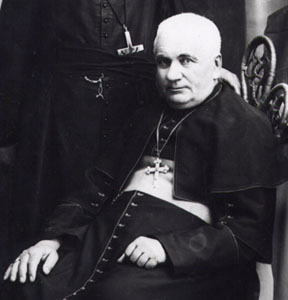Vital-Justin Grandin facts for kids
Quick facts for kids Venerable Vital-Justin Grandin OMI |
|
|---|---|
| Bishop of St. Albert | |

Vital-Justin Grandin, c. 1900
|
|
| Diocese | Diocese of St. Albert |
| In Office | 1871–1902 |
| Successor | Émile-Joseph Legal |
| Other posts | Bishop of Satala (titular) |
| Orders | |
| Ordination | 1854 (priest) |
| Consecration | 1859 |
| Personal details | |
| Born | 8 February 1829 Saint-Pierre-sur-Orthe, France |
| Died | 3 June 1902 (aged 73) St. Albert, Alberta, Canada |
| Denomination | Roman Catholic |
Vital-Justin Grandin (born February 8, 1829 – died June 3, 1902) was a Roman Catholic priest and bishop. He served the Church in the western parts of what is now Canada. Grandin is known for his role in creating the Canadian Indian residential school system. These schools are now understood to have caused great harm to Indigenous cultures and families. Because of this, many places named after him have been renamed since 2021.
Contents
Early Life and Mission Work
Vital-Justin Grandin was born in Saint-Pierre-sur-Orthe, France, on February 8, 1829. He was one of fourteen children in his family. In 1851, he joined the Missionary Oblates of Mary Immaculate, a religious group. He became a priest in 1854.
Just one month after becoming a priest, Grandin was sent to Canada. He was to do missionary work in an area then called Rupert's Land. He arrived in Saint-Boniface and later worked at missions in Fort Chipewyan and Île-à-la-Crosse. He learned to speak the languages of the local Indigenous people to help with his work.
Becoming a Bishop
On December 11, 1857, Pope Pius IX chose Grandin to be a special assistant bishop to Bishop Alexandre-Antonin Taché. He was given the title of "titular bishop of Satala." This meant he was a bishop but did not yet have his own diocese.
Grandin traveled widely to understand the needs of the missions. He helped plan new church areas. In 1871, a new area called the Diocese of St Albert was created. Grandin became its first bishop.
Role in Residential Schools
Bishop Grandin strongly supported the idea of residential schools for Indigenous children. He believed these schools would help Indigenous people "become civilized." He thought this would help them avoid disappearing as a culture.
In 1880, he wrote a letter to a government minister, Hector-Louis Langevin. Grandin explained that boarding schools were the best way for children to "forget the customs, habits & language of their ancestors." He believed this would help them live more like white settlers.
The 2015 Report of the Truth and Reconciliation Commission of Canada stated that Grandin "led the campaign for residential schooling." He thought parents would willingly send their children. He wrote that Indigenous parents wanted their children to have a "better prospect" for the future.
Grandin also wrote to Canada's first prime minister, John A. Macdonald. He said that children raised in these schools "are no longer Indians." He claimed they wanted to live like white people. Grandin suggested the government let them keep children from age five until they were adults. He traveled to Ottawa to convince the government and church leaders to support this plan. Today, many people see his efforts as part of a plan to erase Indigenous cultures.
Developing the Diocese
Bishop Grandin was often not in good health. Despite this, he worked hard to expand the Diocese of St. Albert. He helped start new missions and churches across Alberta. He also oversaw the building of hospitals and schools. These schools were often run by women from religious orders, which was unusual at the time.
Grandin also tried to encourage more French-speaking people to settle in Alberta. While this was less successful, some French-speaking communities he helped found, like Beaumont, Lacombe, and Morinville, still exist today.
Death and Legacy
Bishop Grandin died on June 3, 1902, while still serving as bishop. Bishop Émile-Joseph Legal took his place in the Diocese of St. Albert.
After his death, the Roman Catholic Church began a process to declare him a saint. In 1966, he was declared "venerable." This is a step in the process of becoming a saint.
Changes to Grandin's Name
For many years, many places were named after Grandin, especially in the Edmonton area. These included businesses, schools, and parts of the city's transportation system. Some murals were even painted to honor him.
However, in 2011, an Indigenous group in Edmonton said a mural of Grandin glorified residential schooling. They called it a "cultural genocide." In June 2021, after the discovery of possible unmarked graves at a former residential school site in Kamloops, British Columbia, public opinion against Grandin's role in residential schools grew stronger.
As a result, officials in Edmonton and St. Albert, along with private businesses, began removing his name from buildings and places. Similar changes happened in other cities like Winnipeg and Calgary.
- June 9, 2021: The city of Edmonton voted to rename the Grandin LRT station. They also decided to remove a mural of Grandin from the station.
- June 15, 2021: Grandin Fish ‘n’ Chips restaurant changed its name to Prairie Fish ‘n’ Chips.
- June 28, 2021: Edmonton Catholic Schools voted to rename Grandin School. They also removed a mural of Bishop Grandin from the school's outside wall.
- June 28, 2021: Calgary Catholic School District voted to rename Bishop Grandin High School to Haysboro Catholic High School.
- June 28, 2021: Greater St. Albert Catholic Schools voted to change the name of Vital Grandin Catholic Elementary School. Signs were removed right away.
- October 27, 2022: Calgary Catholic School District confirmed the final name change of Bishop Grandin High School to Our Lady of the Rockies High School.
- March 13, 2023: Winnipeg announced it would rename streets. Bishop Grandin Boulevard became Abinojii Mikanah. Bishop Grandin Trail became Awasisak Mēskanow, and Grandin Street became Taapweewin Way.
See also

